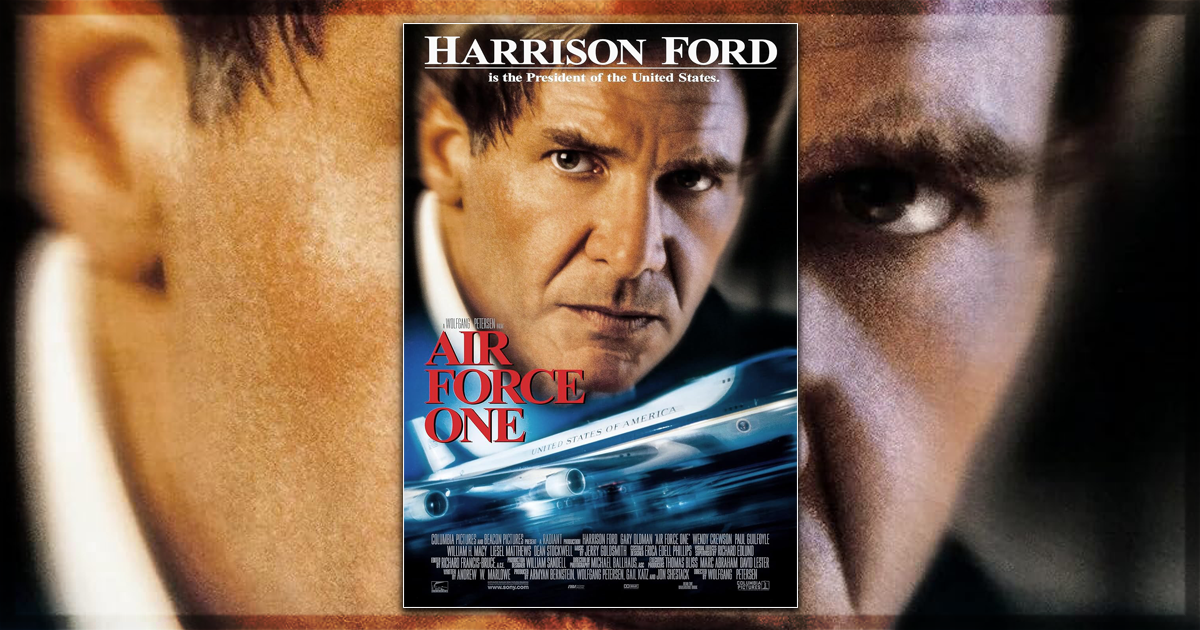German master crafter of epic-scope action films, Wolfgang Petersen, famous for his Academy-Award nominated 1982 World War II Das Boot, later in his life became a name in Hollywood for when you needed an author to sculpt a large-scale action film. Petersen ranges from the classic heartbreaking family movie The Neverending Story in 1984 to the troubled production of the Homer-based Troy in 2004. Petersen has established himself as highly competent in well-crafted Blockbusters. In this sense, in 1997, only six years after the dissolution of the Union of Soviet Socialist Republics, the U.S.S.R, he would present Air Force One. Telling the hijacking story about the kidnap of the American President and his presidential plane.
Written by Andrew W. Marlowe, the film narrates a group of Soviet terrorists who murder a press crew to rob their identity and hijack Air Force One after the travel of American President James Marshall (Harrison Ford) to Moscow, Russia. Therefore, on the way back to his country, a betrayal by a member of the safety team of the President allows the group led by Ivan Korshurnov (Gary Oldman) to take over the control of the airship. They initiate increasing chaos in the American government, requiring a quick reaction from Vice President Kathryn Bennett (Glenn Close) and her emergency cabinet. Unfolding as Korshurnov promotes more violence inside the plane, President Marshall decides not to evacuate through his escape pod and chooses to fight back against the terrorists.
Borrowing the stylistic tendencies of the action thrillers of that era, such as Die Hard, Petersen paints his take on the trend with his scope and magnitude. Most of the film takes place inside a Boeing 747 146 plane, brilliantly replicated by William Sandell and his art department. The directing and writing choices of setting the film inside the aircraft for most of its length create a sense of constant suffocation. Additionally, the actors move constantly throughout the scenario in a scheme of hide-and-seek persecution. Marshall is hiding from the Russians while he tries to communicate with external help via multiple ideas, such as sending a fax to the emergency room in D.C. and leaking fuel to force the hijackers to react, giving him time. These situations provide a sense of action and tension that smoothly rises. Editor Richard Francis-Bruce, an expert in thrillers, blockbusters, and action flicks whose credits would eventually include Se7en, Mad Max Beyond Thunderdome, and Harry Potter and the Philosopher’s Stone, is responsible for controlling and expanding stress and its emotional effects. Francis-Bruce supplies a work that carefully drags the dramatic scenes to worry the viewer and amplify the anxiety. Combined with Petersen’s directing, it is responsible for the operation of the whole scheme of the story’s structure.
Furthermore, the film aligns with other 1990s action efforts as it denies the realistic approach to the genre and invests in the absurdity of its events. Petersen does not go for rationality. He searches for what is best for cinematic proposes. And it works almost entirely once the viewer embarks on the absurdity of what the film portrays. Rather than unbelievable explosions and illogical personal combats, the film fails when it tries to balance a subplot of a coup in the cabinet commanded by the Vice President. It is a flawed construction of a political subtext, which drags the film duration and makes the development of what is happening in the plane a secondary priority. The film is at its best when it forgets the political plot and provides action sequences throughout the film. Thus, Gary Oldman as Korshunov is the ideal villain to navigate the antagonism of the film. His body expressions indicate his intentions of reestablishing the U.S.S.R and getting his life back. However, it lacks development in his intentions and background story, even though he delivers substantial work with a lack of substance to his character.
Air Force One is a solid addition to the Wolfgang Petersen canon of heroic people reacting to large-scale tragedies. His approach to the subgenre of hijacking, popularized in the 1990s with Die Hard, is an amusing and flawed action flick. It has the mannerisms of the last century of action films, but it dives deep into its denial of logic and realism. It thrives in the chaos in that limited space in the sky rather than the political conspiracy coup sub-plot that does not work entirely and the lack of material for Close. However, the outstanding conducting of an action master delivers a commercial action thriller of a high caliber with some of the best editing and sound design of the 1990s mainstream cinema.


